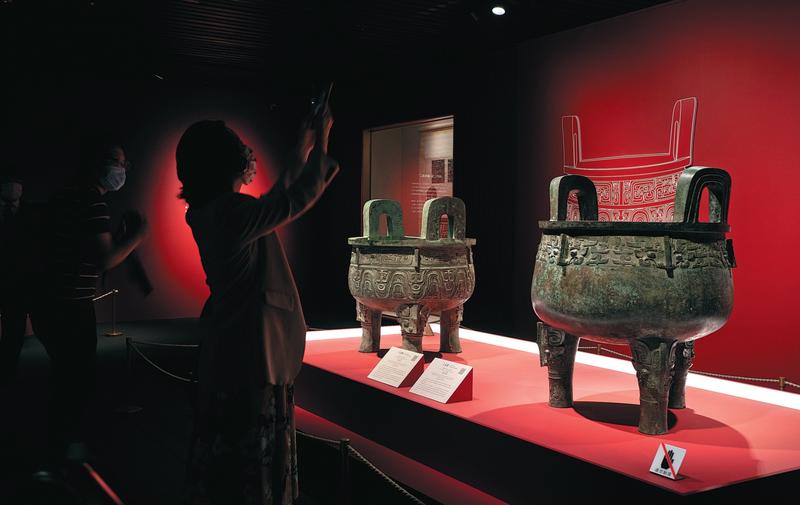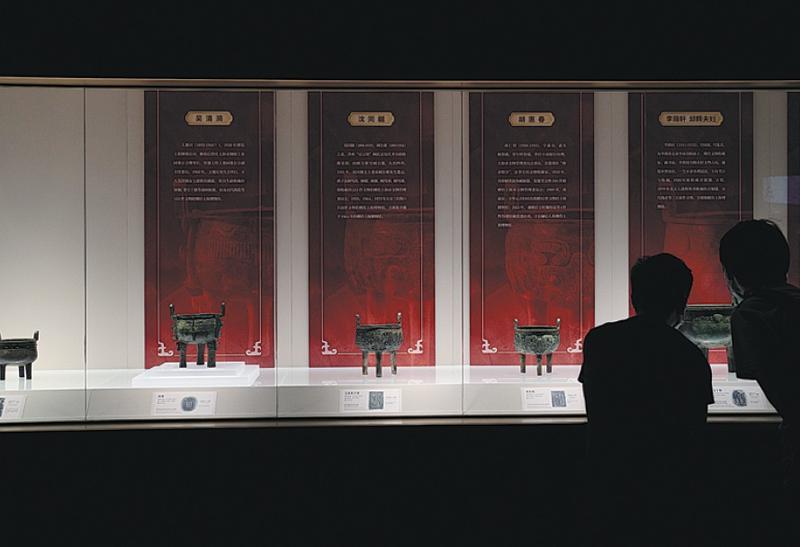Two ancient Ding treasures, saved from turmoil, are reunited for a major exhibition, Zhang Kun reports in Shanghai.
 Dayu Ding (right) and Dake Ding are major attractions of The Perpetual Prosperity. (GAO ERQIANG / CHINA DAILY)
Dayu Ding (right) and Dake Ding are major attractions of The Perpetual Prosperity. (GAO ERQIANG / CHINA DAILY)
Among 21 bronze vessels on show at The Perpetual Prosperity: Special Exhibition of Donated Ding to the Shanghai Museum, the two largest and most celebrated cauldrons used to belong to one family.
The exhibition, which started on June 19 and will run for a month, features bronze Ding, a food vessel widely used in sacrificial ceremonies in ancient China. Dating back to between the 13th century BC and the Warring States Period (475-221 BC), these 21 exhibits represent the evolution of bronze culture in ancient China, including its rise to prominence and the various turning points in development of styles and formation.
The Shanghai Museum had selected these 21 vessels from its collection of ancient Chinese bronze, one of the best in the world, for this exhibition. The exhibition is one of the events organized by the museum to commemorate the centennial of the Communist Party of China.
"All of them were donated by philanthropists, collectors and connoisseurs," says Yang Zhigang, director of the museum.
"We hope to take the opportunity to commend the donors, and honor their selfless contribution to the Party and the nation, their passion and dedication in collecting antiques, and their courage and strength in guarding these treasured pieces."
Since its establishment in 1952, the Shanghai Museum has received generous donations from all over the world. Yang says 23.6 percent of the museum's treasured pieces came from public donations.
Ma Jinhong, deputy head of the bronze department at the museum, says the generosity of donors has played an irreplaceable role in the museum's establishment of a bronze civilization collection.
 Special Exhibition of Donated Ding to the Shanghai Museum; the museum has desserts and beverages decorated with their images. (GAO ERQIANG / CHINA DAILY)
Special Exhibition of Donated Ding to the Shanghai Museum; the museum has desserts and beverages decorated with their images. (GAO ERQIANG / CHINA DAILY)
Ding is a bronze vessel unique to China. It is a cauldron usually supported by three legs, or sometimes four or more. These objects were used to store meat for sacrificial ceremonies and were often considered symbols of supreme power and national authority.
Cauldrons with inscriptions are especially valuable because of the historical information in the inscribed text. Three cauldron tripods with inscriptions are believed to be the most treasured Ding pieces in China. They are Dayu, which is now part of the National Museum's collection in Beijing; Dake in Shanghai Museum; and Maogong, or the Duke Mao Tripod, in the Palace Museum in Taiwan.
Dayu and Dake are stars of the ongoing exhibition at the Shanghai Museum.
Dayu Ding dates back to the mid-11th century BC. It is 101.9 centimeters tall, has a diameter of 77.8 centimeters, and weighs 153.5 kilograms. Dake Ding was made in the late 10th century BC and is 93.1 cm high, has a diameter of 75.6 cm and weighs more than 200 kg.
Both were unearthed in Shaanxi province in the late 1800s and were acquired by Pan Zuyin, a high-ranking official, scholar and antique collector.
After Pan passed away, his antique collection of more than 600 bronze objects were shipped from Beijing to his ancestral home in Suzhou, Jiangsu province.
Pan's only heir was his adopted grandson Pan Chengjing who died young. So Ding Suzhen, wife of Pan Chengjing, took it upon herself to safeguard the family treasures. To solidify her sense of purpose, Ding changed her name to Pan Dayu, a name taken from one of the bronze cauldrons, Dayu Ding.
When Japanese planes were bombing Suzhou in 1937, Ding hid the bronze treasures in a space underneath her living room with the help of two loyal servants.
Though the Japanese repeatedly raided the Pan house for the famous collection, they never found it.
 Other cauldrons on show at the Shanghai event. (GAO ERQIANG / CHINA DAILY)
Other cauldrons on show at the Shanghai event. (GAO ERQIANG / CHINA DAILY)
In 1944, Pan Dayu moved the bronze artifacts to a small room and hid them behind used furniture and ragged clothes.
Shortly after Shanghai was liberated and the People's Republic of China was established in 1949, she wrote to the cultural administration of East China in 1951, announcing the family's decision to donate the two treasured bronze cauldrons to the country.
It took an entire day for the two bronze cauldrons to be transported by train from Suzhou to Shanghai. At the railway station, they were lifted onto a big cart and pulled by hand to the antiques administration office.
The two cauldrons were the most prominent exhibits at the Shanghai Museum when it opened in 1952. Dayu was moved to Beijing in 1959 for the opening of the new National Museum of History.
To mark Pan Dayu's 100th birthday in 2004, the museum held a special exhibition in her honor and Dayu Ding was returned to the museum. With her son and daughter supporting her, Pan Dayu walked around the two bronze cauldrons.
"The two brothers have met again. Not one thing about them has changed. How wonderful is this!" said Pan in the Suzhou dialect. The centenarian passed away peacefully in Suzhou in 2007.
At the opening ceremony of The Perpetual Prosperity exhibition on June 19, Pan Yuyi, grandson of Pan Dayu, again compared the two cauldrons to brothers.
"They went through fear and turmoil together during the war, and started new lives in museums," Pan Yuyi says.
"My grandmother had so much comfort 17 years ago seeing the tripods visited by thousands of people every day. She said she found the best home for the bronze brothers-the warmest and safest home."
 From left: Dake Ding, from the late 10th century BC, is one of the most treasured Ding pieces in China; a leg of Dake Ding featuring carved patterns; Dayu Ding, another treasured tripod dating back to the mid-11th century BC; inscriptions inside Dayu Ding. (PHOTO PROVIDED TO CHINA DAILY)
From left: Dake Ding, from the late 10th century BC, is one of the most treasured Ding pieces in China; a leg of Dake Ding featuring carved patterns; Dayu Ding, another treasured tripod dating back to the mid-11th century BC; inscriptions inside Dayu Ding. (PHOTO PROVIDED TO CHINA DAILY)
Maogong Ding, one of the three most treasured bronze Ding of China, can be seen at the exhibition in the form of a collage as it currently resides in Taiwan's Palace Museum, having left the mainland together with Kuomintang forces in 1948.
The Shanghai Museum has also introduced a new merchandise series to complement the exhibition. Aside from silk scarves and bags bearing the images of Dake Ding or its inscribed patterns, the museum has also added Ding themed macarons, coffee, cocktails and ice creams to its cafe menu.
Another exhibition now on at the museum is An Everlasting Spring: The Art of Painting and Calligraphy in Shanghai. Consisting of 146 pieces of artwork created in the past 1,000 years, the exhibition marks the first academic study on the correlation between art and the city of Shanghai.
Among the exhibits are paintings by renowned masters active in Shanghai and nearby regions, artworks that reflect the local culture and lifestyle, as well as those depicting important figures and historical events in the city, according to Ling Lizhong, head of the painting and calligraphy department at the Shanghai Museum.
The majority of the artworks are on exhibition at the Shanghai Museum for the first time, and some have come from other museums and institutions in the city like the Shanghai Library and the Shanghai Academy of Painting and Calligraphy.
If you go
The Perpetual Prosperity: Special Exhibition of Donated Ding to the Shanghai Museum
June 19-July 18
An Everlasting Spring: The Art of Painting and Calligraphy in Shanghai
June 22-Sept 21 9 am-5 pm, Tuesday-Sunday
Museum viewing reservations are required to be made on WeChat. Shanghai Museum, 201 Renmin Avenue, Huangpu district, Shanghai. 021-6372-3500
Contact the writer at zhangkun@chinadaily.com.cn


